This Korean Vegetarian Bibimbap rice bowl is savory, sweet, tangy, and a little spicy! It's filled with vegetables that you can pick and choose from and is customizable depending on the season.
Looking for more delicious Korean-inspired dishes? Japchae Korean Stir-Fried Glass Noodles, Asian Cucumber Salad, or my Korean Zucchini Pancakes!
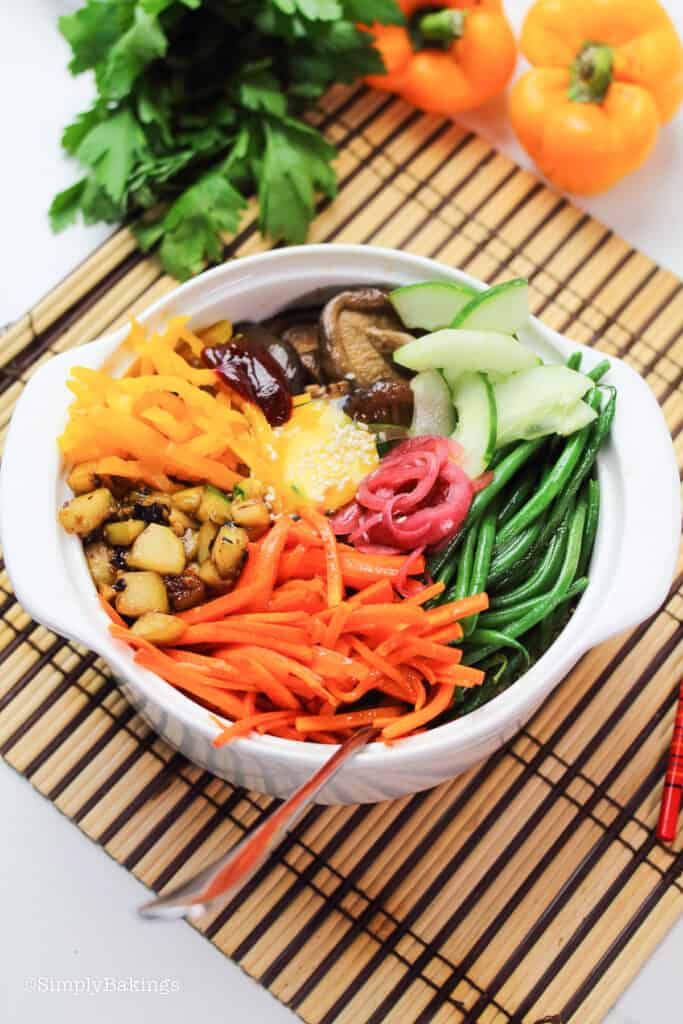
What is Bibimbap?
Bibimbap is a popular Korean rice dish made with a bowl of steamed white rice and topped with individually prepared sautéed seasoned vegetables (namul) or fermented vegetables like kimchi, chili pepper paste (gochujang), and soy sauce or fermented soybean paste (doenjang) then stirred together thoroughly just before eating
. In Korean, the term bibim means “mixed” and bap means “rice”, so bibimbap literally means “mixed rice”.
Koreans traditionally make this hot dish during lunar new year's eve to clear out their pantries at the year’s end, putting and mixing their leftovers together into their rice bowls and then serving for dinner.
Bibimbap was first mentioned by name in a late-19th-century cookbook, Siuijeonseo. There are some theories that suggest it was a traditional dish for farmers during the harvest as it can be easily cooked to feed many farmhands, or that it originates in the jesa ancestral rites wherein the foods would be assembled in a bowl to be offered as a gift to ancestors.
The best and most fun part of making this Korean rice bowl is that it has no strict rules for making the toppings so you can just pick and choose your vegetable and protein combinations whatever you got on hand and make your own version of it! Plus, you can make it in advance so it’s definitely a versatile and meal-prep-friendly vegetarian dish!

Tips and Procedures:
- Make your bibimbap bowl colorful and appetizing by selecting no fewer than 2 or 3 veggies in different colors.
- Vegetarian topping options: bean sprouts, spinach, coconut aminos, fried egg, daikon, tofu, tempeh, natto, seitan, and mock meats.
- Non-vegetarian topping options: bulgogi beef, roasted or smoked salmon.
- For an ultimate bibimbap experience, it is best to use dolsot which crisps up the bottom layer of the rice and keeps the food warm. Please take note that dolsot only works on gas stoves. Alternatively, you may use an individual-sized cast iron skillet or a large pan.
- Put the vegetables in a sealed container and in the fridge then best finished in 4-5 days.
- Storage: Best eaten immediately, but can be stored in an airtight container for up to 3 days
How to Make Vegetarian Bibimbap:
Listed below are all the ingredients you will need:
- jasmine rice, cooked
- quinoa, cooked
- vegetable oil
- carrots
- vegetarian oyster sauce
- French beans
- yellow bell pepper
- garlic
- zucchini
- black bean sauce
- shiitake mushroom
- teriyaki sauce
- sesame oil
- onions
- cucumber
- sesame seeds
- egg yolk
- gochujang sauce
- salt
- pepper
In a large pan over medium heat, add 1 tablespoon of oil. Then add carrots, and oyster sauce and stir fry for 3 minutes on high heat, remove from pan and set aside. Using the same pan, add a tablespoon of oil and toss the French beans, season with salt and pepper and cook for 3 minutes, then set aside:

In the same pan, sauté minced garlic in a tablespoon of oil. Then add in zucchini and cook for 5 minutes. Add black bean sauce, mix well, then set aside. Wipe the pan to remove the previous seasonings, then add the remaining oil and sauté shiitake mushroom for 5 minutes. Add in teriyaki sauce and allow it to simmer for a minute, then season with salt and pepper to taste:
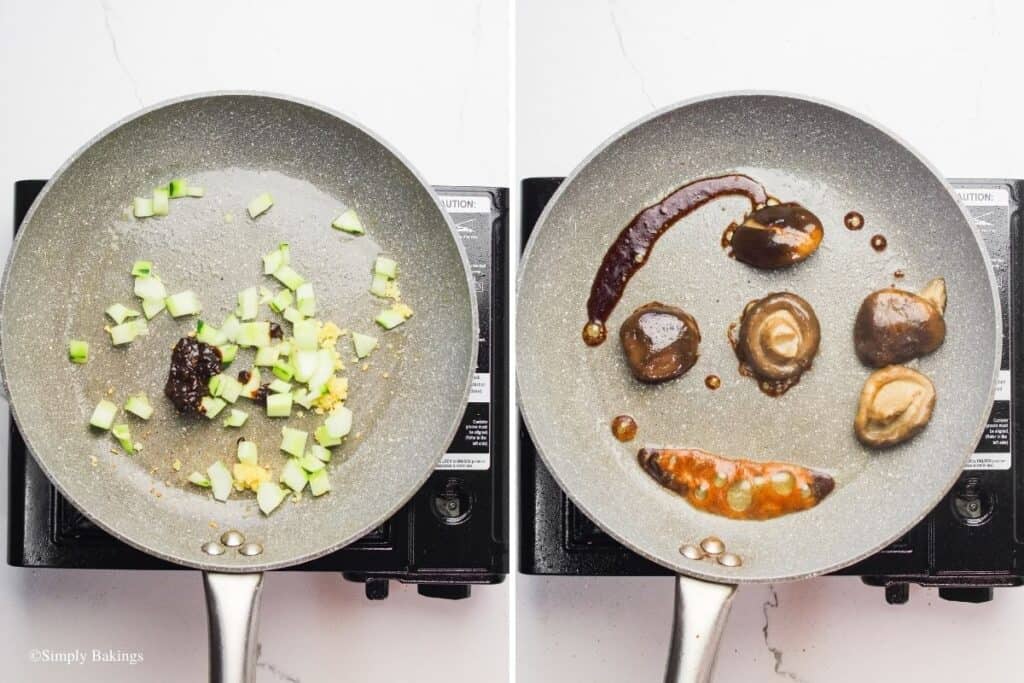
Transfer to a plate. To assemble, brush the dolsot pot with sesame oil:
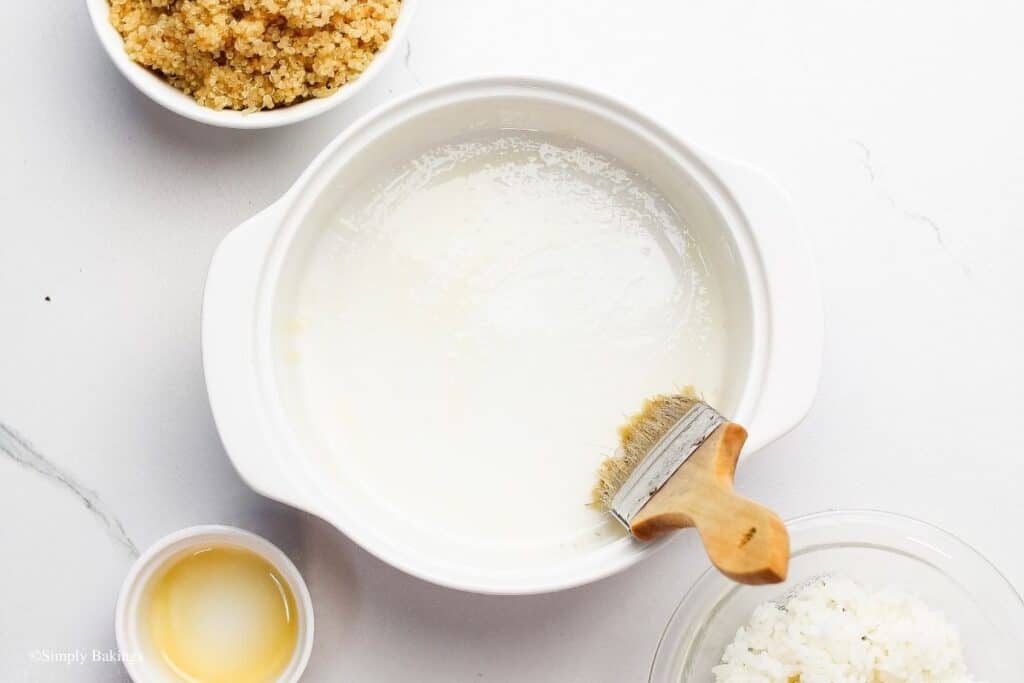
Add a half cup of cooked white rice at the bottom and followed by cooked quinoa:
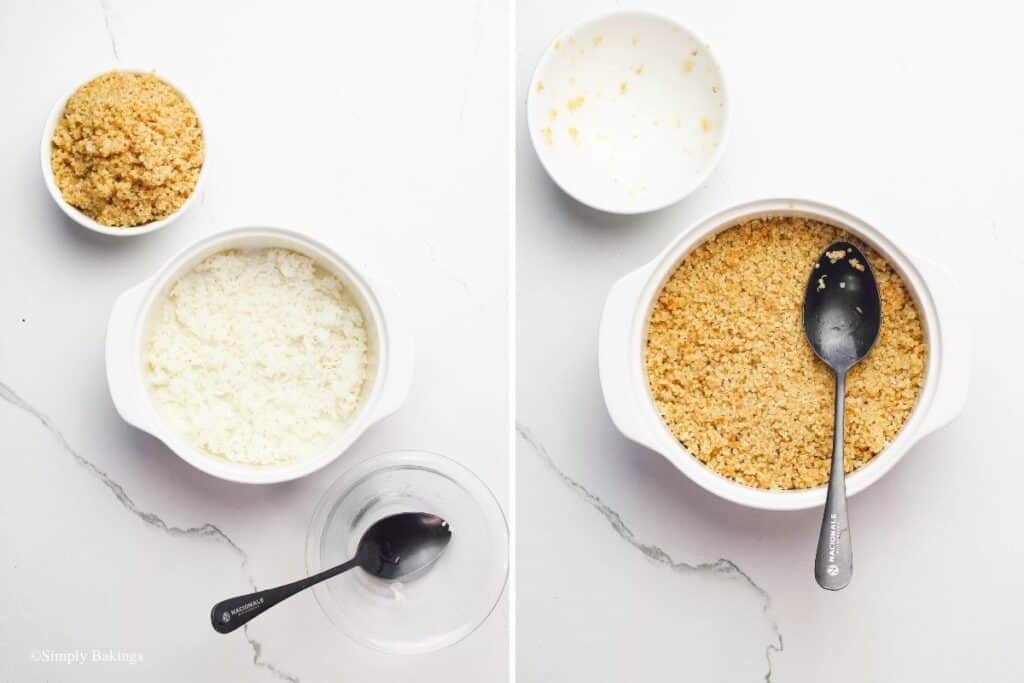
Arrange the vegetables on top of the quinoa:
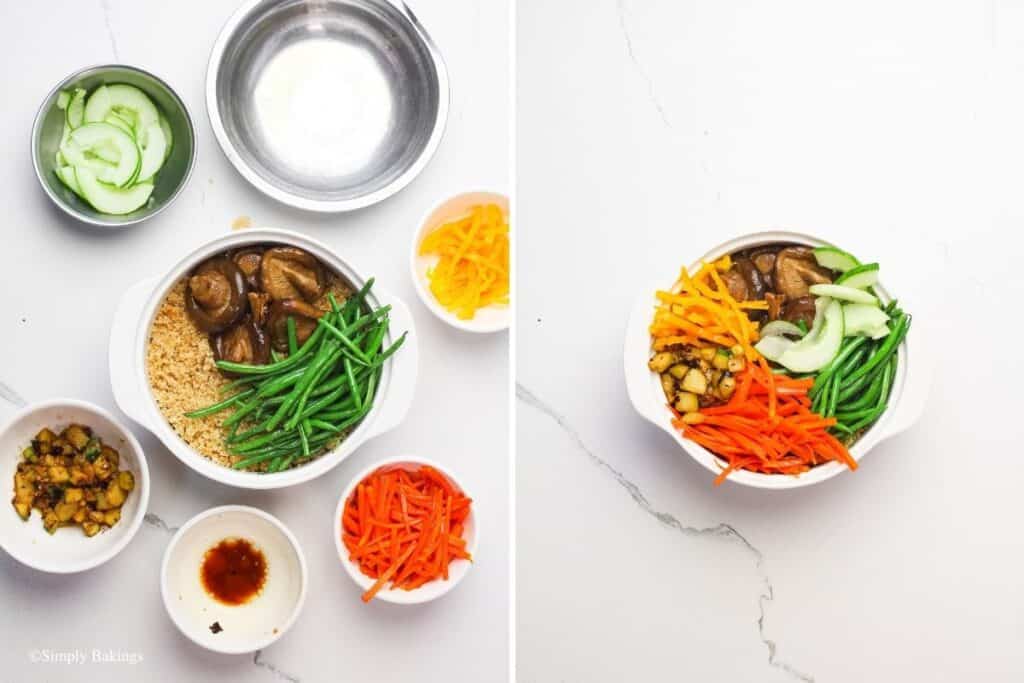
Add pickled onions and egg yolk at the center. Then, sprinkle the sesame seeds on top of the yolk. Next, add gochujang sauce on the side and place the dolsot pot on a stovetop, and heat for 3 minutes or until it sizzles:
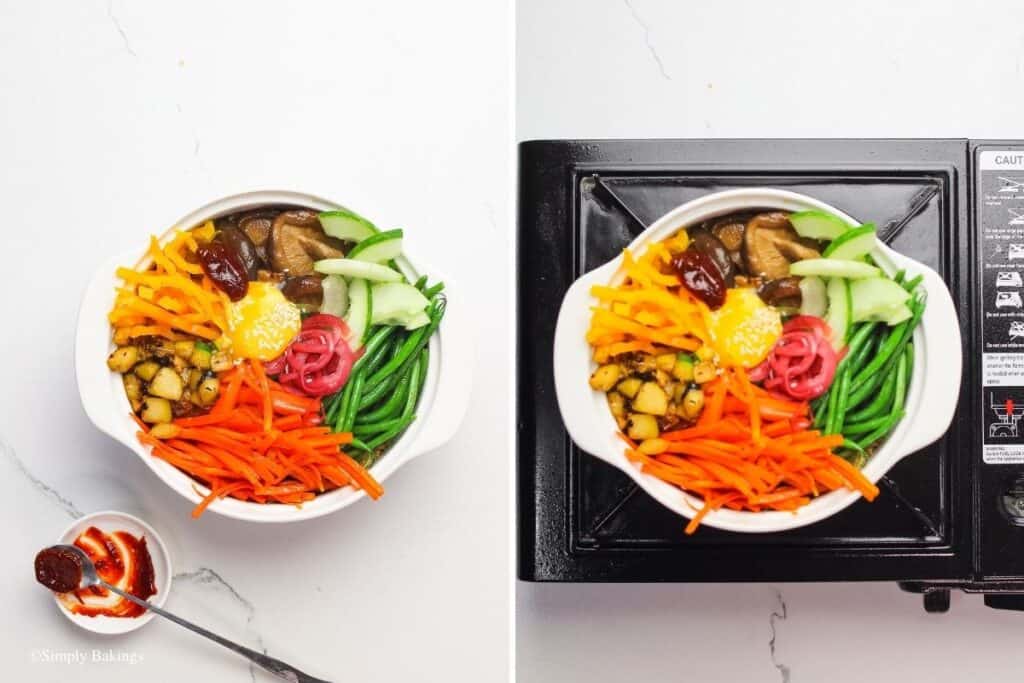
Serve and enjoy!
Frequently Asked Questions:
Bibimbap is usually served with gochujang, which is actually not too spicy.
I used jasmine rice in this dolsot bibimbap. It is usually served with short-grain white rice but short-grain brown rice, mixed-grain rice, or a combination of the two can be used as alternatives.
Yes, of course.
Vegetarian Bibimbap
Ingredients
- ½ cup jasmine rice cooked
- 2 cups quinoa cooked
- ¼ cup vegetable oil
- 3 oz carrots julienned
- 1 tablespoon vegetarian oyster sauce
- 2 oz French beans
- 2 oz yellow bell pepper julienned
- ¼ teaspoon minced garlic
- 2 oz zucchini finely chopped
- 1 tablespoon black bean sauce
- 4 oz shitake mushroom
- 2 tablespoons teriyaki sauce
- 2 teaspoons sesame oil
- 2 tablespoons pickled onions
- 2 oz English cucumber finely sliced
- ¼ teaspoon sesame seeds
- 1 egg yolk
- 1 teaspoon sesame seeds
- salt & pepper
Instructions
- In a large pan over medium heat, add 1 tablespoon oil.
- Then add carrots, oyster sauce and stir fry for 3 minutes on high heat, remove from pan and set aside.
- Using the same pan, add a tablespoon of oil and toss the french beans, season with salt and pepper and cook for 3 minutes, then set aside.
- In the same pan, saute minced garlic in a tablespoon of oil.
- Then add in zucchini and cook for 5 minutes.
- Add black bean sauce, mix well, then set aside.
- Wipe the pan to remove the previous seasonings, then add the remaining oil and saute shiitake mushroom for 5 minutes.
- Add in teriyaki sauce and allow it simmer for a minute, then season with salt and pepper to taste.
To Assemble:
- Brush the dolsot pot with sesame oil.
- Add a half cup of cooked white rice at the bottom and followed by cooked quinoa.
- Arrange the vegetables on top of the quinoa.
- Add pickled onions and egg yolk at the center.
- Sprinkle the sesame seeds on top of the yolk.
- Add gochujang sauce on the side and place the dolsot pot on a stovetop and heat for 3 minutes or until it sizzles, serve hot.


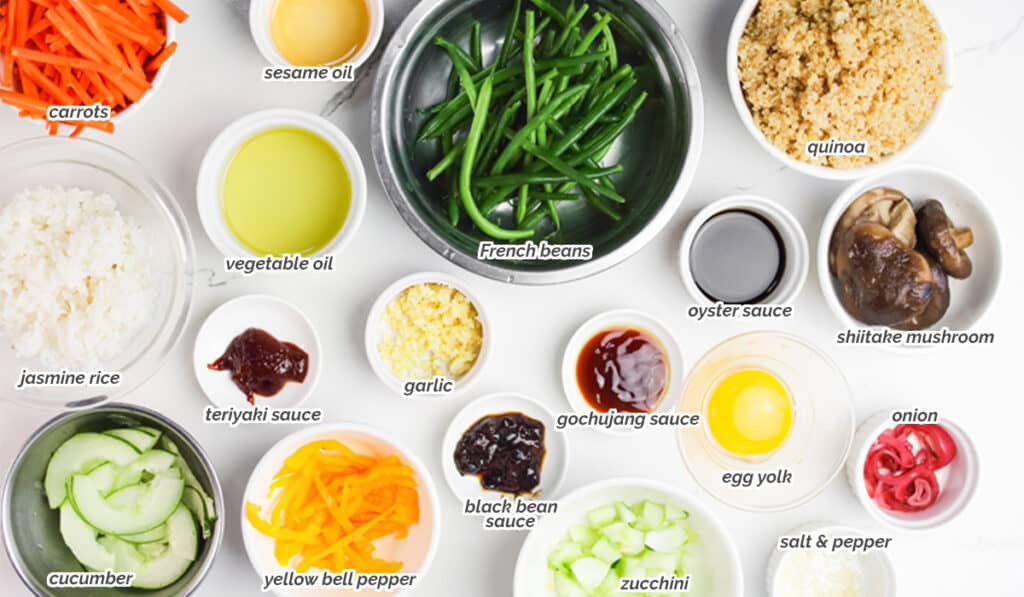
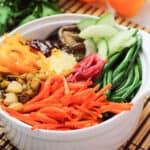
Leave a Reply